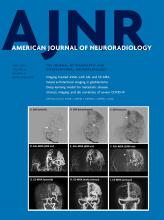We read with great interest the article by Toledano-Massiah et al1 entitled, “Unusual Brain MRI Pattern in 2 Patients with COVID-19 Acute Respiratory Distress Syndrome.” The authors reported 2 patients hospitalized in their intensive care unit with confirmed coronavirus disease 2019 (COVID-19) in whom brain MR imaging had shown an unusual DWI pattern with nodular and ring-shaped lesions involving the periventricular and deep white matter. Based on the recent literature, the authors discussed the probable mechanism of action for Severe Acute Respiratory Syndrome coronavirus disease 2 (SARS-CoV-2) neurologic invasion.
We treated 2 hospitalized patients who share some similarities with the reported unusual brain MR imaging pattern. Patient 1 was a previously healthy 49-year-old man whose CT revealed interstitial pneumonia and with real-time polymerase chain reaction (RT-PCR) was positive for SARS-CoV-2. Endotracheal intubation and mechanical ventilation with prolonged sedation were required because of severe respiratory failure. He presented with delayed recovery of consciousness after protracted sedation. Patient 2 was a previously healthy 9-year-old child with a family history of COVID-19 who had difficulty walking and speaking, right hemiparesis, and impaired ocular motor function. There were no respiratory symptoms. The serologic test for COVID-19 was positive.
Brain MR imaging was performed on day 30 from hospitalization for patient 1 (day 5 after the sedation) (Fig 1) and on day 7 for patient 2 (day 37 after the first symptoms) (Fig 2). At that time, patient 1 showed progressive clinical and laboratory improvement of COVID-19, and patient 2 remained without respiratory symptoms with blood RT-PCR negative for SARS-CoV-2. The CSF RT-PCR for SARS-CoV-2 was negative for patient 1 and not available for patient 2.
FLAIR images (A–C) depict multiple nodular/oval hyperintensities that involve the deep and periventricular cerebral white matter, splenium of the corpus callosum, and pons. All lesions show restricted diffusion on DWI sequences (D–F). Neither gadolinium enhancement (G–I) nor hemorrhages (not shown) were demonstrated.
Axial T2WI (A–C) demonstrates multiple large hyperintense oval lesions predominantly affecting the subcortical WM of the cerebral hemispheres, the posterior arm of the right internal capsule, and the infratentorial fossa structures, particularly in the middle cerebellar peduncles. All lesions concurrently demonstrate diffusion restriction observed in the diffusion sequence (D–F) and gadolinium enhancement in the postcontrast T1 sequence (G–I). Most lesions have an open-ring enhancement pattern, best characterized in the right middle cerebellar peduncle (arrowhead in I).
Even though the authors have concluded that the etiology and physiopathology of these unusual brain lesions are still not clarified, these 2 additional patients reinforce the inflammatory mechanism hypothesis. Acute disseminated encephalomyelitis (ADEM) is a rare immune-mediated demyelinating disease that has been associated with vaccine and viral infections, including SARS-CoV-2 infection.2
The causative neuropathogenic mechanism of SARS-CoV-2 infection should be carefully analyzed. In particular, patient 2 was asymptomatic for about 30 days, and the RT-PCR test was not performed. Nevertheless, we presumed that the infection had acted as a trigger for developing an autoimmune response that manifested in the central nervous system as ADEM in these 2 additional patients. The perception that the appearance of neurologic symptoms had happened simultaneously with both progressive clinical and laboratory improvement or after the SARS-CoV-2 infection reinforces this hypothesis. Furthermore, the imaging findings also suggested an “ADEM-like” pattern.
In conclusion, we thank the authors for sharing their experiences. Together, we provide valuable information about unusual brain MR imaging patterns in patients with COVID-19. We believe that given the cumulative evidence of the probable neuroinvasive nature of SARS-CoV-2, the association of COVID-19 with neurologic manifestations cannot be ignored, either by direct cytopathic effect or, mainly, by an immune-mediated inflammatory response. Thus, it is vital to be aware of the multitude of neurologic manifestations in patients with COVID-19 and be open-minded about possible new clinical-radiologic presentations and courses.
Indicates open access to non-subscribers at www.ajnr.org
References
- © 2021 by American Journal of Neuroradiology














